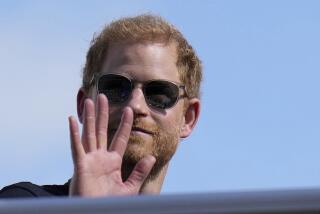Hoffman’s Suit Against Magazine Over Photo Layout Goes to Judge
- Share via
The fate of Dustin Hoffman’s lawsuit against Los Angeles Magazine for using his photo from the hit movie “Tootsie” to promote a designer gown and high heels is now in the hands of a federal judge.
U.S. District Judge Dickran Tevrizian took the case under submission Friday after hearing closing arguments in the nonjury trial.
Lawyers said they expect the judge to issue his verdict in writing, given the significant constitutional issues raised by the lawsuit.
“This case has major implications about what you can and cannot do in the name of editorial content,” Tevrizian said during the four-day trial.
Los Angeles Magazine says that it is protected from liability by the 1st Amendment, while Hoffman’s lawyers contend that the Constitution does not give the press unbridled freedom to exploit someone’s name and image for commercial gain.
The actor is seeking $3 million to $5 million in compensation along with punitive damages from the magazine and its parent, Capital Cities ABC, which is now part of the Walt Disney Co.
In a March 1997 spread titled “Grand Illusions,” the magazine used a computer to dress famous movie stars, some long dead, in the latest spring fashions.
A head shot of Hoffman, who appeared in drag in “Tootsie,” was lifted from a studio still shot and stitched to a picture of a male model dressed in the gown and shoes.
A caption next to the composite read: “Dustin Hoffman isn’t a drag in a butter-colored silk gown by Richard Tyler and Ralph Lauren heels.” In the back of the magazine, a buyer’s guide listed prices and stores where the items could be bought.
Hoffman testified during the trial that he steadfastly refused to make product endorsements as a matter of artistic principle and pride, although he had plugged Volkswagens as a rising star in the late 1960s. The magazine acknowledged that it did not seek his permission when it used his photo.
In his closing argument Friday, Charles Shephard, the actor’s lawyer, called Hoffman “one of the most passionate and principled actors when it comes to protecting his name.”
He referred to trial testimony that in 1997 the magazine was millions of dollars in debt and struggling to boost readership, a problem its editor tried to correct by featuring more Hollywood celebrities.
“They wanted to make a splash,” he said. “They wanted Mr. Hoffman’s likeness. They knew it wasn’t for sale, and even if it was for sale, they knew they couldn’t afford it. So they stole it. They took an extremely valuable right and they should be made to pay for it.”
The trial produced a lively debate over whether the fashion layout was editorial in content or a disguised commercial ad.
Frank Lalli, a senior executive editor at Time Inc. and former president of the American Society of Magazine Editors, testified for the magazine that anyone seeing the spread would conclude it was editorial in nature, despite the boost it gave to Richard Tyler and Ralph Lauren.
In a countermove, Hoffman’s lawyers commissioned a market researcher to conduct a random survey of 100 shoppers. They were shown the layout and asked if it was intended to sell clothes. Eighty-four percent of the respondents answered yes, the survey’s author testified.
Notwithstanding the disagreement over whether the layout was editorial or commercial, Hoffman’s attorney argued that the actor was entitled to compensation under state and federal laws because the magazine engaged in deception by making it appear as if Hoffman had modeled the evening gown and high heels. The lawyer also cited the actor’s publicity rights under common law.
Steven Perry, representing the magazine, argued that the fashion spread was “editorial speech protected by the 1st Amendment.”
But he also contended that Hoffman had no right to sue because the photo used in the magazine belonged to “Tootsie’s” copyright holder, not to Hoffman.
Moreover, he said, “this is not his likeness. This is the likeness of the character he played, not of Mr. Hoffman.” As for the unauthorized mention of Hoffman’s name, Perry said that came from a movie poster also covered by the “Tootsie” copyright.
“The copyright holder could have sued us for what we did, but not Mr. Hoffman,” Perry told the judge.
Viewing the layout, he said, is like witnessing a magic show and “seeing a woman being sawed in half. You react when you see it, but everybody knows it’s not for real.”
In addition to Hoffman’s image, the layout included computer-generated pictures of Cary Grant, Harold Lloyd, Marilyn Monroe, Vivian Leigh, Elvis Presley, Susan Sarandon, Geena Davis, John Travolta, Marlene Dietrich and Jane Russell.
More to Read
The biggest entertainment stories
Get our big stories about Hollywood, film, television, music, arts, culture and more right in your inbox as soon as they publish.
You may occasionally receive promotional content from the Los Angeles Times.










